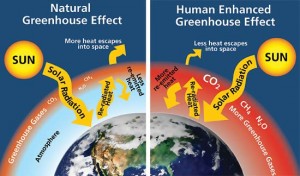Every day we use the Earth’s land and resources for many different activities. Land allows us to grow crops that turn into our meals, and water from our lakes is home to the fish we catch and the water we drink. The Earth provides us with all kinds of services, but did you know that some of your activities may have a negative effect on the environment? Sometimes we may pollute without even realizing that what we are doing could be harming our planet! Explore this section to discover how your day to day lifestyle could be affecting the environment.
Ecological Footprint
Did you know that if everyone in the world lived the same lifestyle as Canadians, we would need 3.5 Earths to support our way of life? You can see how many Earth’s are required to fit your lifestyle by finding out your ecological footprint. An ecological footprint is a measure of how much of the Earth’s land and resources we use. Activities such as walking to school instead of getting a ride from your parents, or turning off the tap while brushing your teeth, can all reduce your ecological footprint. See how many planet Earths are needed to maintain your way of life by taking the ecological footprint quiz!
Carbon Footprint
Many of the activities that you do every day release carbon into the atmosphere. Certain gases in the atmosphere such as water vapour and carbon dioxide trap energy from the sun, warming the temperature of the Earth. This is known as the greenhouse gas effect. This is named after greenhouses which trap in heat from the sun, allowing plants to grow year round in colder climates. You may have experienced a similar effect if you’ve ever sat inside a car that had been parked in the sunlight for a long time. The greenhouse effect can be both a good and a bad phenomenon. A greenhouse effect is good because without gases trapping in warmth in the Earth’s atmosphere, our planet would be too cold for humans and animals to live on. The greenhouse effect becomes bad for the environment when there are too many greenhouse gases released into the atmosphere which cause the Earth to warm up to a higher temperature than normal. Even a small rise in temperature can have devastating results for plants and animals. For example, the smallest rise in temperature can cause sea ice to melt which will make it difficult for polar bears to hunt seals. It could also cause lake temperatures to rise resulting in certain species of fish unable to survive the change in climate. The rise in greenhouse gases being emitted into the atmosphere has contributed to global warming. Fortunately there are things we can all do to reduce our greenhouse gas emissions. For example, we can put on a sweater when we’re cold instead of turning up the thermostat. What other ways can you think of to reduce your carbon footprint?
To better understand the greenhouse gas effect, check out the U.S. Environmental Protection Agency’s Climate Change Kids’ Page! You can also check out this website to read more about global warming and ways in which we can help prevent it!
If you want to know how much carbon you release into the atmosphere, take the carbon footprint quiz!
Once you’ve learned what type of activities increase your carbon footprint, check out National Geographic’s fun game on how to reduce carbon emissions in your community!
Where does all the Water go?
Water is a vital component to our survival. All living things require water, which is why it is so important to protect out planet’s water resources. We use water every day for things such as washing dishes, taking a shower, or watering plants, but we don’t always think about where the water comes from or where the water ends up.
Try playing the Down the Drain You Go game to learn about where your water goes after you watch it travel down the drain!


